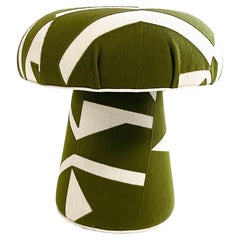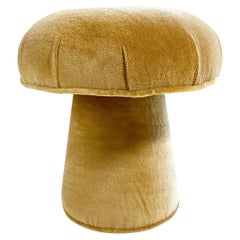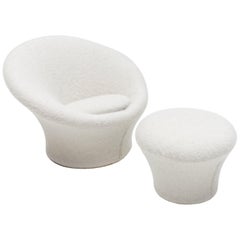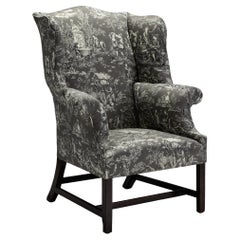Mushroom Pierre Frey
2010s American Ottomans and Poufs
Fabric
2010s American Ottomans and Poufs
Mohair
Recent Sales
Mid-20th Century Dutch Mid-Century Modern Armchairs
Metal
Antique 18th Century English Armchairs
Cotton
Mid-20th Century Dutch Mid-Century Modern Armchairs
Metal
Mid-20th Century Dutch Mid-Century Modern Armchairs
Metal
Mid-20th Century Dutch Mid-Century Modern Armchairs
Metal
People Also Browsed
2010s British Scandinavian Modern Ottomans and Poufs
Velvet, Mohair, Oak
2010s Cambodian Benches
Fabric, Oak
21st Century and Contemporary Italian Modern Coffee and Cocktail Tables
Blown Glass
2010s Italian Organic Modern Chandeliers and Pendants
Natural Fiber
1990s Italian Mid-Century Modern Chandeliers and Pendants
Brass
2010s American Flush Mount
Brass
2010s British Scandinavian Modern Tables
Mohair, Oak
2010s American Console Tables
Oak
2010s French Other Wall Mirrors
Ceramic
21st Century and Contemporary British Organic Modern Wall-mounted Sculpt...
Plaster
2010s American Modern Benches
Sheepskin, Hickory, Leather
Vintage 1970s Swiss Mid-Century Modern Sofas
Leather
2010s Dutch Modern Side Tables
Marble
21st Century and Contemporary German Mid-Century Modern Chandeliers and ...
Metal, Iron
21st Century and Contemporary American Scandinavian Modern Wall Lights a...
Steel, Zinc
2010s American Mid-Century Modern Table Lamps
Brass
Artifort for sale on 1stDibs
The sterling reputation that Artifort enjoys isn’t limited to the innovative upholstery and fluid, organic shapes for which its products are widely known — the legendary Dutch brand’s vintage seating and other furniture is also celebrated for its embodiment of functionality, comfort and quality. These are among the principles that underpin the philosophy toward modern furniture design at Artifort, which has been at the crossroads of furniture and art for over 125 years.
Prior to 1928, the year Artifort officially became a brand, Jules Wagemans had a small upholstery business in Maastricht, the Netherlands. After setting up in 1890, his son, Henricus Wagemans, broadened the scope of the company to include furniture production. By the end of the 1920s, their showroom in Amsterdam had made them a recognizable brand across the Netherlands.
Then named H. Wagemans & Van Tuien, the company changed its name to Artifort after the economic recession. Artifort came from two Latin words meaning “art” and “strong” — a perfect description for the style of each design and the manufacturer’s intention to create sturdy furnishings. Artifort’s reputation for durable armchairs and sofas endures, and vintage editions of this seating are now family heirlooms in many homes.
Artifort became a magnet for high-profile and up-and-coming designers alike. Many furniture designers’ careers began thanks to collaborations with Artifort, such as Dutch industrial and jewelry designer Gijs Bakker and Indonesian-born designer Kho Liang Ie. Also known for designing the interiors at Amsterdam’s Schiphol Airport, Kho Liang Ie was an aesthetic consultant at Artifort and used his expertise to turn the company into a world-class brand. Perhaps his largest contribution, however, was attracting the talents of French furniture and interior designer Pierre Paulin and English furniture designer Geoffrey D. Harcourt.
Paulin’s bright and colorful lounge chairs, such as his Orange Slice chair and Mushroom chair, are still central to the Artifort identity. The revered designer not only introduced new construction techniques to Artifort furniture, but contributed fresh materials, Pop art colors and dazzling shapes to the mid-century modern era as a whole, while Harcourt deserves credit for popularizing Artifort internationally and extending their reach into foreign markets.
Another talent boom in the 1990s at Artifort yielded collaborations with Jasper Morrison, Wolfgang Mezger and René Holten. Iranian designer Khodi Feiz was named art director in 2014 and has continued the tradition of recruiting top designers such as Claesson Koivisto Rune, Ilse Crawford and Luca Nichetto.
Find a collection of vintage Artifort lounge chairs, tables and more on 1stDibs.
A Close Look at Mid-century-modern Furniture
Organically shaped, clean-lined and elegantly simple are three terms that well describe vintage mid-century modern furniture. The style, which emerged primarily in the years following World War II, is characterized by pieces that were conceived and made in an energetic, optimistic spirit by creators who believed that good design was an essential part of good living.
ORIGINS OF MID-CENTURY MODERN FURNITURE DESIGN
- Emerged during the mid-20th century
- Informed by European modernism, Bauhaus, International style, Scandinavian modernism and Frank Lloyd Wright’s architecture
- A heyday of innovation in postwar America
- Experimentation with new ideas, new materials and new forms flourished in Scandinavia, Italy, the former Czechoslovakia and elsewhere in Europe
CHARACTERISTICS OF MID-CENTURY MODERN FURNITURE DESIGN
- Simplicity, organic forms, clean lines
- A blend of neutral and bold Pop art colors
- Use of natural and man-made materials — alluring woods such as teak, rosewood and oak; steel, fiberglass and molded plywood
- Light-filled spaces with colorful upholstery
- Glass walls and an emphasis on the outdoors
- Promotion of functionality
MID-CENTURY MODERN FURNITURE DESIGNERS TO KNOW
- Charles and Ray Eames
- Eero Saarinen
- Milo Baughman
- Florence Knoll
- Harry Bertoia
- Isamu Noguchi
- George Nelson
- Danish modernists Hans Wegner and Arne Jacobsen, whose emphasis on natural materials and craftsmanship influenced American designers and vice versa
ICONIC MID-CENTURY MODERN FURNITURE DESIGNS
- Eames lounge chair
- Nelson daybed
- Florence Knoll sofa
- Egg chair
- Womb chair
- Noguchi coffee table
- Barcelona chair
VINTAGE MID-CENTURY MODERN FURNITURE ON 1STDIBS
The mid-century modern era saw leagues of postwar American architects and designers animated by new ideas and new technology. The lean, functionalist International-style architecture of Le Corbusier and Bauhaus eminences Ludwig Mies van der Rohe and Walter Gropius had been promoted in the United States during the 1930s by Philip Johnson and others. New building techniques, such as “post-and-beam” construction, allowed the International-style schemes to be realized on a small scale in open-plan houses with long walls of glass.
Materials developed for wartime use became available for domestic goods and were incorporated into mid-century modern furniture designs. Charles and Ray Eames and Eero Saarinen, who had experimented extensively with molded plywood, eagerly embraced fiberglass for pieces such as the La Chaise and the Womb chair, respectively.
Architect, writer and designer George Nelson created with his team shades for the Bubble lamp using a new translucent polymer skin and, as design director at Herman Miller, recruited the Eameses, Alexander Girard and others for projects at the legendary Michigan furniture manufacturer.
Harry Bertoia and Isamu Noguchi devised chairs and tables built of wire mesh and wire struts. Materials were repurposed too: The Danish-born designer Jens Risom created a line of chairs using surplus parachute straps for webbed seats and backrests.
The Risom lounge chair was among the first pieces of furniture commissioned and produced by celebrated manufacturer Knoll, a chief influencer in the rise of modern design in the United States, thanks to the work of Florence Knoll, the pioneering architect and designer who made the firm a leader in its field. The seating that Knoll created for office spaces — as well as pieces designed by Florence initially for commercial clients — soon became desirable for the home.
As the demand for casual, uncluttered furnishings grew, more mid-century furniture designers caught the spirit.
Classically oriented creators such as Edward Wormley, house designer for Dunbar Inc., offered such pieces as the sinuous Listen to Me chaise; the British expatriate T.H. Robsjohn-Gibbings switched gears, creating items such as the tiered, biomorphic Mesa table. There were Young Turks such as Paul McCobb, who designed holistic groups of sleek, blond wood furniture, and Milo Baughman, who espoused a West Coast aesthetic in minimalist teak dining tables and lushly upholstered chairs and sofas with angular steel frames.
Generations turn over, and mid-century modern remains arguably the most popular style going. As the collection of vintage mid-century modern chairs, dressers, coffee tables and other furniture for the living room, dining room, bedroom and elsewhere on 1stDibs demonstrates, this period saw one of the most delightful and dramatic flowerings of creativity in design history.
Finding the Right Armchairs for You
Armchairs have run the gamut from prestige to ease and everything in between, and everyone has an antique or vintage armchair that they love.
Long before industrial mass production democratized seating, armchairs conveyed status and power.
In ancient Egypt, the commoners took stools, while in early Greece, ceremonial chairs of carved marble were designated for nobility. But the high-backed early thrones of yore, elevated and ornate, were merely grandiose iterations of today’s armchairs.
Modern-day armchairs, built with functionality and comfort in mind, are now central to tasks throughout your home. Formal dining armchairs support your guests at a table for a cheery feast, a good drafting chair with a deep seat is parked in front of an easel where you create art and, elsewhere, an ergonomic wonder of sorts positions you at the desk for your 9 to 5.
When placed under just the right lamp where you can lounge comfortably, both elbows resting on the padded supports on each side of you, an upholstered armchair — or a rattan armchair for your light-suffused sunroom — can be the sanctuary where you’ll read for hours.
If you’re in the mood for company, your velvet chesterfield armchair is a place to relax and be part of the conversation that swirls around you. Maybe the dialogue is about the beloved Papa Bear chair, a mid-century modern masterpiece from Danish carpenter and furniture maker Hans Wegner, and the wingback’s strong association with the concept of cozying up by the fireplace, which we can trace back to its origins in 1600s-era England, when the seat’s distinctive arm protrusions protected the sitter from the heat of the period’s large fireplaces.
If the fireside armchair chat involves spirited comparisons, your companions will likely probe the merits of antique and vintage armchairs such as Queen Anne armchairs, Victorian armchairs or even Louis XVI armchairs, as well as the pros and cons of restoration versus conservation.
Everyone seems to have a favorite armchair and most people will be all too willing to talk about their beloved design. Whether that’s the unique Favela chair by Brazilian sibling furniture designers Fernando and Humberto Campana, who repurposed everyday objects to provocative effect; or Marcel Breuer’s futuristic tubular metal Wassily lounge chair; the functionality-first LC series from Charlotte Perriand, Le Corbusier and Pierre Jeanneret; or the Eames lounge chair of the mid-1950s created by Charles and Ray Eames, there is an iconic armchair for everyone and every purpose. Find yours on 1stDibs right now.



